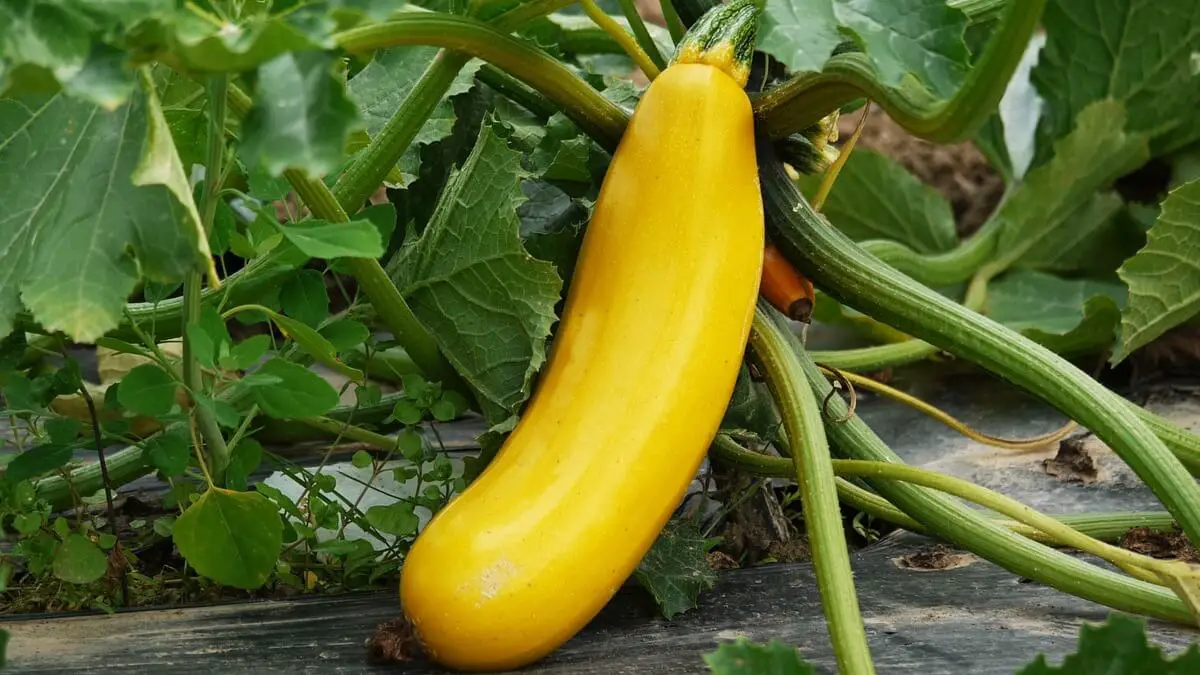How to Grow Golden Zucchini in Garden
The golden zucchini is also known as yellow or golden courgette. It is a part of the Cucurbitaceae family, just like other summer squashes. It originates from Mesoamerican origin. In general, zucchini, including golden zucchini is a garden staple. You can find its historical roots originating from as early as 5,500 BC.
This article focuses on zucchini, particularly golden zucchini, its propagation, caring, harvesting, and benefits
Even though many consider golden zucchini as a vegetable, technically, it qualifies as a fruit.
In general, the zucchini plants (including golden zucchini) are prolific producers. They develop fruits quickly. The color and size of the fruits make them easy to spot, as leaves cannot hide them. This helps in identifying the right time to harvest easily. It also makes the harvesting process easy.
Many people confuse golden zucchini with yellow squash. In spite of both being summer squashes, they are different in nature.
Normally, you can distinguish both of them by their respective shapes. Golden zucchini has an elongated shape. yellow squash usually has a straight or flat bottom. Its shape tapers near the neck. Sometimes, it also has a curved neck like a swan.
Table of Contents
Characteristics of Golden Zucchini
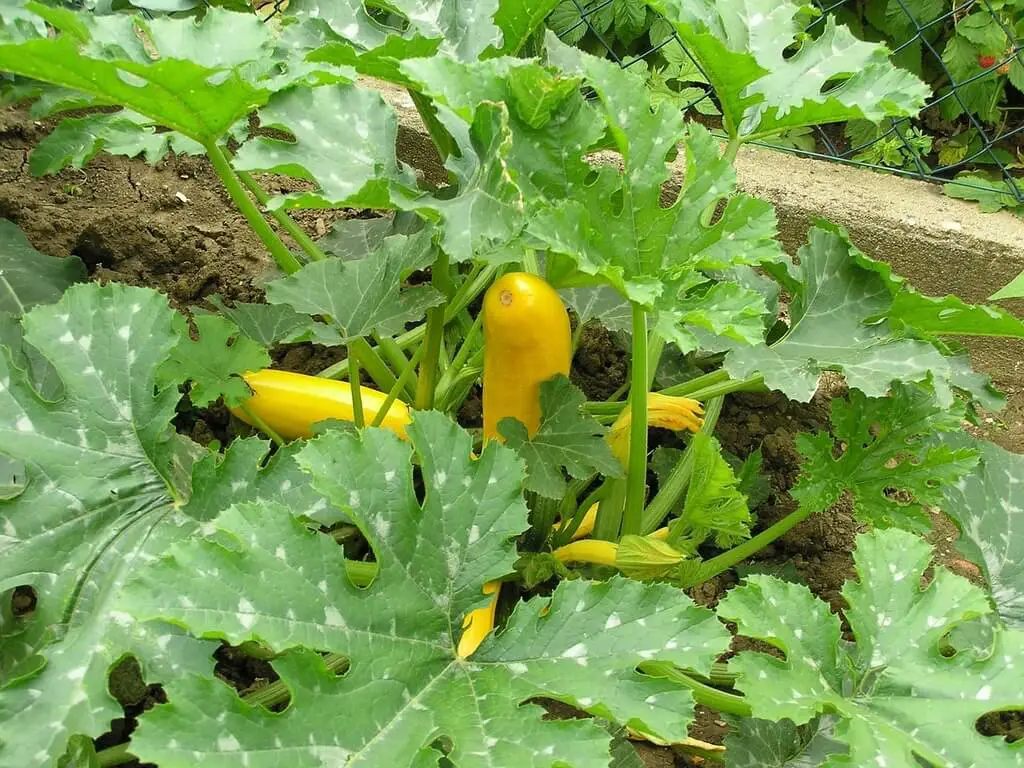
In fact, the golden zucchini is a traditional heirloom. It has a bushy appearance. Hence, it needs a large space in gardens to grow freely. Zucchinis’ in common, are easy to grow. They require plenty of water and a hot climate, similar to other typical summer squashes, for healthy growth.
The large flowers of golden zucchini are usually yellow in color. They have a star shape with a yellow central head. zucchini blooms tend to fall off from the plants frequently. This is a part of the production process and is completely normal.
The fruits are usually long, slender, and bright yellow or golden in color. However, the color may vary from medium green to yellow or gold. The outer skin toughens and the seeds harden with the fruit growth.
Both the green zucchini and golden zucchini have an almost similar flavor. However, many consumers consider golden zucchini to be sweeter than its green counterpart. The fresh and early ones, particularly golden zucchini, have a bright texture and delicate flavor.
Propagation of Golden Zucchini
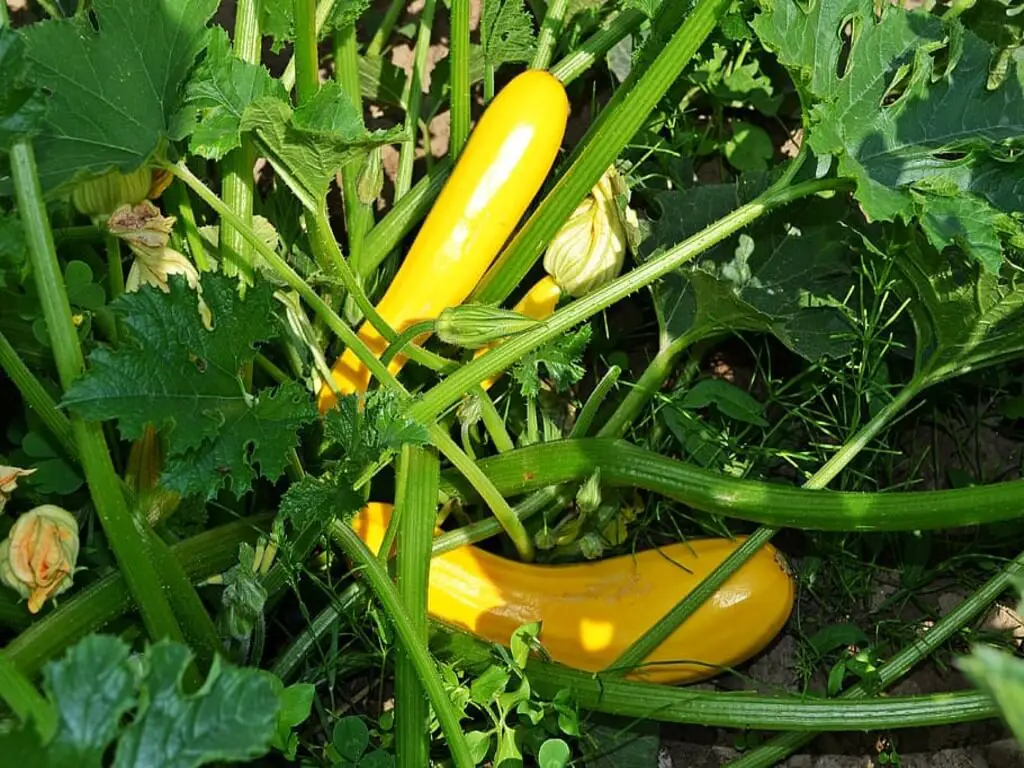
Both green and golden zucchinis have identical requirements for growing.
Generally, they prefer to grow in well-draining soils with a PH range of 6.0 – 7.5. Select a spot that receives at least 6- 8 hours of sunlight during the day. The more sunlight they receive, the happier they grow.
Naturally, they require more space to grow! So, make sure the distance between the plants is at least two feet. This also helps to prevent common pests and diseases.
We also recommend you select a space where you did not plant squash or other related crops previously. (At least for two previous years.)
In general, these plants require pollinator insects for pollination (producing fruits). Hence, we recommend you grow plants that attract beneficial insects, along with zucchinis.
Some of the famous companion plants for this purpose include Marigold, borage. You can also try planting daisies (zinnias, coneflower, sunflower, cosmos, Etc.,) and mints (oregano, beebalm, lavender, sage, Etc.,)
In addition, you can grow rows of beans, tomatoes, peppers, and other herbs to border the space edges.
The more the bees serve, the more the fruits develop. Hence, try to attract as many bees as possible, by planting more companion plants.
You can find more about pollinators in this guide. Make sure to purchase one and keep handy.
From Seeds
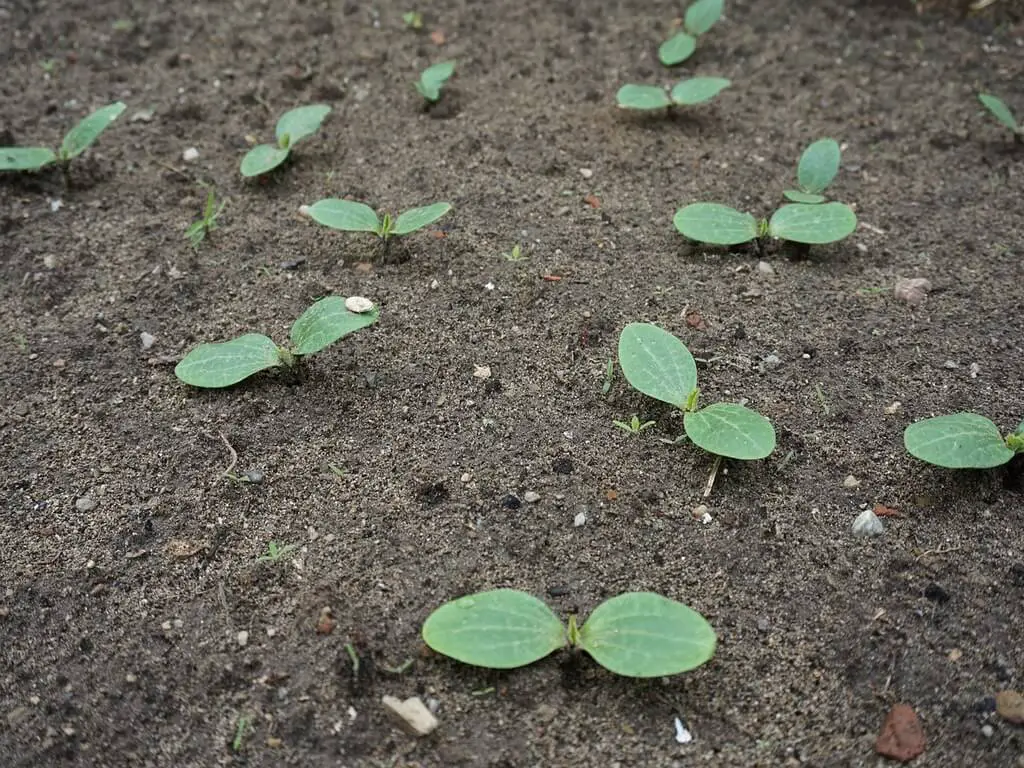
You can purchase golden zucchini seeds online or at any nursery nearby. Start the sowing process, after the frost. Make sure the night temperatures stay above 55-degree Fahrenheit consistently.
You can sow the seeds directly in your garden. Sow them at least 36 inches apart at a depth of 1 inch. Firm the soil gently. After that, water regularly and maintain the soil moisture.
Normally, you can expect the seedlings to emerge within a short span of 10 – 14 days. When they have two sets of true leaves, thin them by pulling out unhealthy ones.
If you grow them in rows, make sure the distance between the rows is about 2- 3 feet. You also have the option of growing about 2 plants per hill, instead of rows.
Alternatively, you can grow them indoors and transplant them after germination. Use this method if you are unsure of nighttime temperatures. We recommend you to use biodegradable pots for indoors growing. This helps to prevent transplant shocks which can damage the roots.
Growing Golden Zucchini

Cover the space around the plants with mulch. Generally, mulching helps to prevent weed prefoliation. This is essential because the weeds compete with plants for water and other soil nutrients.
Mulching also helps to maintain soil temperatures by retaining moisture. This helps to strengthen the shallow roots of golden zucchinis.
Normally, golden zucchini needs 1 – 2 inches of water per week to grow healthy. So, keep a watch on soil moisture particularly during dry spells.
Water in the early mornings. This helps to dry applied water on plants using daytime hot temperatures. Therefore, you can prevent most of the common plant diseases that arise due to wetness.
Avoid over-watering too. This may cause root rots and other related diseases.
We recommend you to use a drip or trickle system for watering. This system waters the plants at the soil level with low pressure. In this way, you can retain the soil moisture and also maintain the soil temperature to some extent, easily.
Harvesting Golden Zucchini
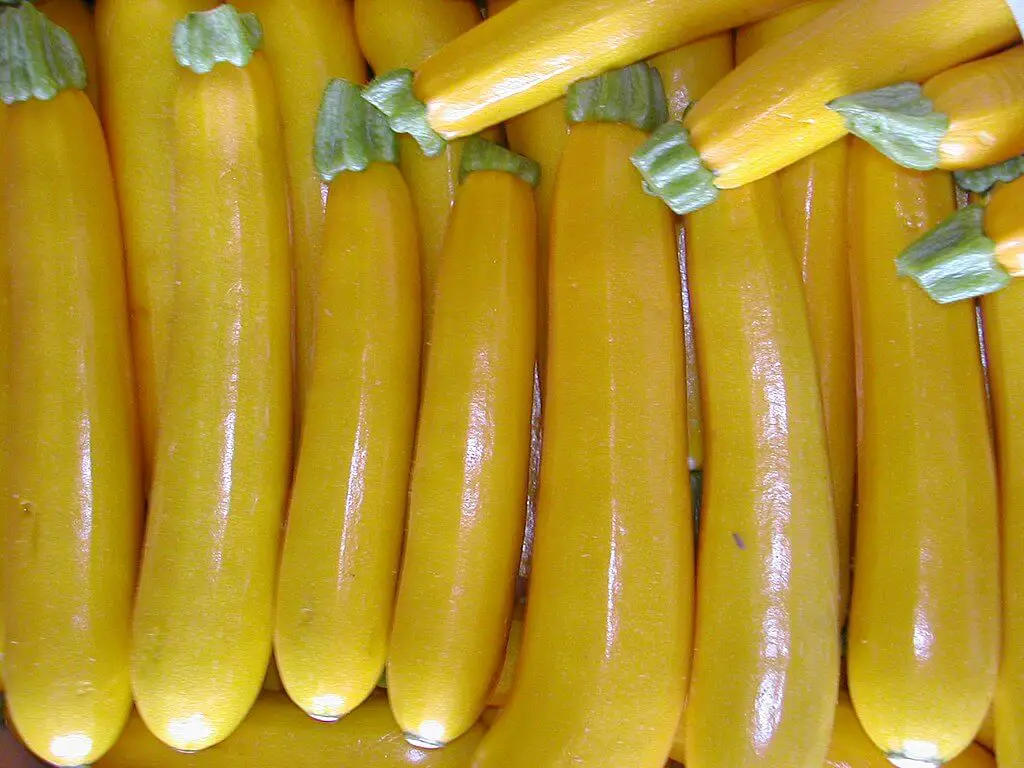
Photo by Mikani (Wikimedia Commons) (CC BY-SA 2.0 FR)
When the tender golden zucchinis are about six inches long, you can harvest them. Make sure to pick them at their tender stages before their shiny, glossy skin toughens. This encourages the plants to develop fresh fruits again. If you allow the fruits to mature, the plants may stop further production.
Just twist them gently until they snap off from the plants. Instead, use good quality garden shears to cut off the fruits from plants. This prevents you from damaging the plants while harvesting.
You can store the Golden zucchini fruits at room temperatures for up to 5 days. However, you can store them in a refrigerator for up to two weeks. These time periods may vary depending on the health of the fruit and also the temperature range.
Pests and Diseases
Generally, the Zucchini plants, including golden zucchini are very easy to grow. They also start yielding quickly. In spite of these benefits, these plants do have some disadvantages comparatively. There are some common pests and diseases that bother them quite frequently.
Pests
Some of the pests that bother these plants include Vine borers, cutworms, Leaf miners, cucumber beetles, aphids, Thrips, spider mites, whiteflies, and squash bugs
Most of them can be treated with pesticides or insecticidal soaps. But, different pests attack at different stages of growth. So, we recommend you begin a pest control regimen at the initial stages (of the plant) itself. Always keep a guide handy to deal with pests.
Diseases
Some diseases that often affect these plants include botrytis blight, downy mildew, bacterial wilt, powdery mildew, yellow mosaic virus.
Once these diseases infest zucchini plants, they become fatal. Most of the time, the plants cannot recover. Hence, it is advisable to avoid these diseases in the first place. There are some precautions that you can follow as described below:
Grow the plants in spaces that get maximum sunlight. Water the plants regularly. While doing so, aim at roots, not the foliage. Avoid overwatering. If possible, use a drip or trickle watering system.
Facilitate plenty of airflow by allowing adequate free spaces around the plants. Most importantly, keep the pests away by treating your plants proactively.
Squash Blossom End Rot
Generally, this disease affects the fruits, if the plants have a calcium deficiency.
Calcium facilitates the plant to form a stable structure. In the case of calcium deficiency, the cell formation ceases and good cells start to collapse.
Initially, this affects the bottom of the fruit, as it grows faster than other parts. As a result, the bottom portion of the fruit turns spongy and rots. However, the affected fruits are still edible. But, they lack the original taste and commercial value.
If left untreated, the plants may have stunted growth and die finally.
Precautions
Plants need to intake calcium from the soil, particularly during the production phase. Uneven watering can hinder this process. Hence, water evenly and regularly.
Too much nitrogen can cause the leaves to grow vigorously. Slow-growing roots may not be able to intake sufficient calcium for these leaves. Hence, we recommend you amend the soil with low nitrogen fertilizer before planting. However, it is advisable to conduct soil tests occasionally to check the nitrogen content and other deficiencies.
Maintain the soil PH value between 6.0 – 7.5. You can use lime to increase the PH value of soil. You can also use gypsum to increase the calcium content of your soil.
In spite of the above measures, if the disease spreads to the fruit, just snip it off with shears. After that, mist the plants with calcium-rich foliar spray in the early morning. Mix some horticultural oil or insecticidal soap to the spray so that the liquid sticks to the plants for some time. This method ensures proper calcium supply for future fruits.
Nutrition Facts
Generally, the zucchinis, including golden zucchinis, are rich in nutrients. They contain various minerals, vitamins, and other beneficial compounds. As per the USDA’s Food composition database, 223 grams (one cup) of cooked zucchini contains the following:
Protein: 1 gram,
Calories: 17
Sugar: 1 gram
Carbs: 3 grams
Fat: less than 1 gram
Fiber: 1 gram
Manganese: 16% of the RDI
Vitamin A: 40% of the RDI
Vitamin C: 14% of the RDI
Potassium: 13% of the RDI
Vitamin B6: 7% of the RDI
Vitamin K: 9% of the RDI
Magnesium: 10% of the RDI
Phosphorus: 7% of the RDI
Copper: 8% of the RDI
Thiamine: 5% of the RDI
Folate: 8% of the RDI
In addition, these fruits contain zinc, calcium, iron, several antioxidants, and other vitamin B elements that benefit the human body.
For example, Zucchinis are rich in Vitamin A. This element can improve human vision and also strengthen the immune system by boosting essential nutrients.
In fact, both raw fruits and cooked fruits have the same nutrition profile. However, if you cook these fruits, vitamin A content decreases.
Benefits of Consuming Zucchini

Photo by Krista (Wikimedia Commons) (CC BY 2.0)
Generally, the zucchinis (including golden zucchini) are rich in nutrients. Their consumption imparts various health benefits to humans. some of them, we have mentioned below:
Digestion
Naturally, these fruits contain high water composition along with electrolytes, fiber, and other nutrients that aid the digestion process.
Aging
As a matter of fact, these fruits are rich in anti-inflammatory phytonutrients and antioxidants. These components control or gets rid of excess inflammation and free radicals. Thus, zucchinis help to slow down the aging process of humans
Controls Blood Sugar Levels
Avoid food that contains high (unhealthy) carbohydrates content. Increase the consumption of fiber-rich foods. Generally, zucchinis are rich in fibers. So, consuming them helps control diabetes and high blood sugar levels
Blood Circulation and Heart Health
These fruits have high potassium and fiber content. They also have low sodium and fat content. These factors facilitate good blood circulation. The fiber (polysaccharide) content decreases cholesterol levels. This helps to maintain the healthy condition of the human heart.
Eyesight
Generally, zucchinis contain high amounts of phytonutrients and antioxidants. They also contain beta-carotene, manganese, vitamin C, lutein, and zeaxanthin.
lutein and zeaxanthin fight free radicals. This helps to improve or at least maintain the eye visions. This also helps to reduce the risk of developing other age-related eye disorders such as cataracts, glaucoma, and macular degeneration.
Other Benefits
Regular consumption of these fruits helps to prevent IBS, colon cancer, ulcers, Thyroid diseases, oxidation, and inflammation. It also helps in weight loss and boosts energy production in human bodies.
Similar Plants
How to Grow Caraway Plants (Carum Carvi) in Gardens
How to Grow Aster Tataricus (Tatarian Aster) in Gardens

